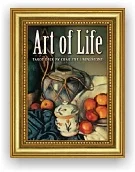The Fine Art of Living Life: A Review of Art of Life Tarot
Art of Life Tarot
Charlene Livingstone
Published by US Games
Review by Christiana Gaudet
With her new Art of Life tarot deck, Charlene Livingstone is not the first to use existing works of art to illustrate a tarot deck. Kat Black’s Golden Tarot used digital collage of medieval art to create a tarot deck very true to the Rider Waite Smith images.
Neither is Charlene Livingstone the first deck creator to ascribe famous quotations to each card of divination; Ciro Marchetti’s Oracle of Visions companion book includes a quotation for each card.
Nevertheless, Art of Life Tarot from U.S. Games is a truly unique and valuable deck. It easily teaches two important concepts with which tarot students often struggle. First is the concept of archetypes. That the deck creator illustrates each card with a famous work of art and famous quotation drives home the concept of archetypes; the idea that each tarot card portrays a universal theme that is repeated many times over in art, music and literature.
The second concept is that tarot is more than a simple device for fortune telling. Tarot cards offer inspiration and bear spiritual wisdom, just as art and literature can. The box in which the oversized cards are packaged actually turns into a standing frame wherein we are encouraged to place one card each day for inspiration.
The accompanying Little White Book is written in the first person by the deck creator, and tells the poignant story of her own tarot journey. The card descriptions are based on key words for suits, numbers and rank. No mention is made of elemental associations.
The cards themselves are large, with a white background. The traditional name of the card is at the top. The top half of the card is a reproduction of a work of art. Under that, in small italics, is the name of the work and the artist. Under that, in large italics, is a quotation. The works of art and quotations are classic. They span several centuries and come from many cultures, although many will be familiar to those of even modest education. There are no ultra-modern works – no album art or wise quotations from Bart Simpson.
I identify Lisa Hunt and Kris Waldherr as the primary innovators of this kind of archetypal assignment tarot deck. What is true for their decks is also true for Art of Life. At the end of the day, artists’ choices are their own, and completely subjective. It is very easy for an experienced tarotist to go through this deck and say, “Why did she choose this painting for that card?” or “I could think of several quotations that would illustrate this card much better!”
The important point is that even if we don’t agree with every choice, this deck gets us thinking about the archetypes of tarot, and how they are expressed in art and words. In this way, Art of Life is engaging and educational.
Some of the cards are particular apt, or at least they speak to me very personally. For instance, the Wheel of Fortune is Mucha’s Zodiac accompanied by the famous passage from Ecclesiastes, “To everything there is a season and a time for every purpose under heaven: a time to weep and a time to laugh; a time to mourn, and a time to dance.”
Another I really like is The Moon, which is Rousseau’s The Sleeping Gypsy. Its quotation is from Thoreau. “Go confidently in the direction of your dreams. Live the life you have imagined.”
Art of Life is a wonderful teaching deck, and a wonderful deck to inspire us about tarot, and about life. As a workable reading deck, some may see it more as an oracle than a standard tarot. Because of the quotations, a novice could easily pull cards at random, or lay them in the simple Creativity Spread included in the LWB, and get a meaningful reading.
I took Art of Life Tarot on a test drive with a simple two-card “This or That” decision making spread, and was shocked by the clarity of the answer. As an experienced reader, I could read blank cards with only the card names on them. But the quotations and the images were particularly striking, and added depth to the standard interpretation of each card.
Art of Life Tarot will serve well as a companion for the tarot journey, rather than as a primary learning or reading deck. Those who are not tarot-centric can use this deck simply as cards of inspiration, divination and meditation. Art of Life Tarot will be especially appealing to lovers of art and literature.
On a side note, this deck is good news for those of us who don’t want to draw but might want to design a tarot deck someday. There are many ways to be creative with tarot, and many ways to illustrate a deck. Charlene Livingstone has done an exemplary job illustrating a tarot deck with the art and words of the masters.
Art of Life Tarot by Charlene Livingstone is a welcome addition to the body of tarot, and will be a welcome addition to most tarotists’ collections. Its title is more descriptive than we might first realize. In meditation and divination, it will most certainly inspire us with counsel from the ages in the fine art of living life.
